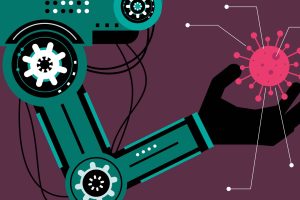
Not long after the 1918 Spanish flu pandemic, Czech writer Karel Čapek first introduced the term “robot” to describe artificial people in his 1921 sci-fi play R.U.R. While we have not yet created the highly intelligent humanoid robots imagined by Čapek, the robots most commonly used today are complex systems that work alongside humans, assisting with an ever-expanding set of tasks.
In a piece in Nature Machine Intelligence, Johns Hopkins researchers discuss how the coronavirus pandemic has driven unexpected innovations in automation, while at the same time revealing bottlenecks to deploying robotic systems in health care settings. They contend that advances in human-robot interaction—such as improving robots’ capabilities to feel, touch, and decide—will determine if the robots of tomorrow will help hospitals stay ahead of the next pandemic.
In the commentary, the team identifies three ways robots have greatly enhanced patient care and provider safety during COVID-19: minimizing contact between infected patients and care providers, reducing the need for PPE, and giving providers more time to focus on critical tasks. They look ahead to how technologies can be leveraged to develop adaptable and reliable robots for future infectious disease crises.
The Hub reached out to commentary authors Axel Krieger and Russell Taylor of the Whiting School of Engineering, and Brian Garibaldi, director of the Johns Hopkins Biocontainment Unit at Johns Hopkins Medicine, for insights on the future of robots during infectious disease outbreaks.